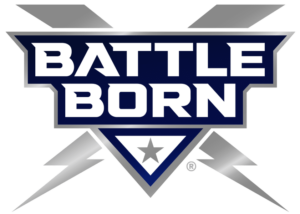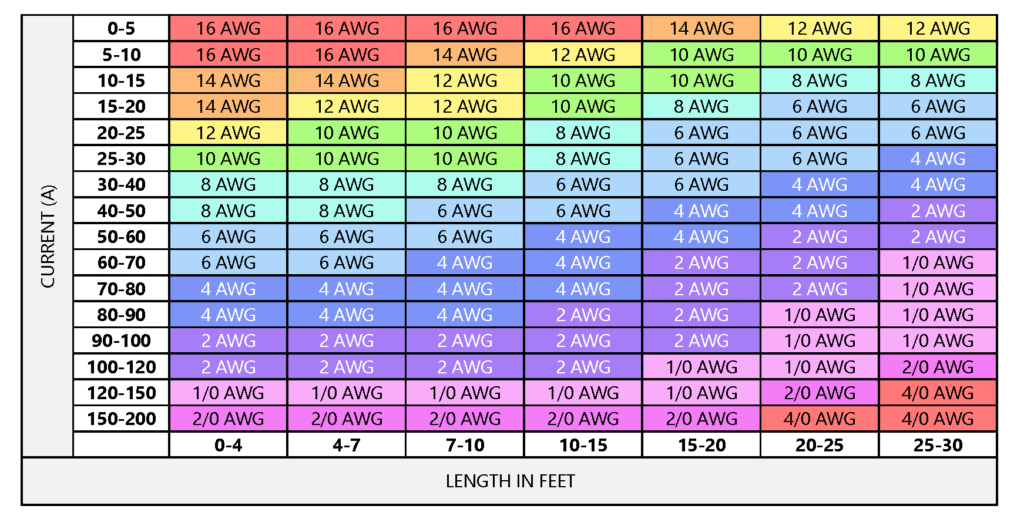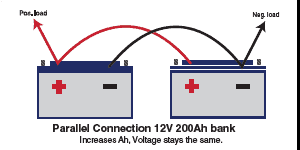Frequently Asked Questions
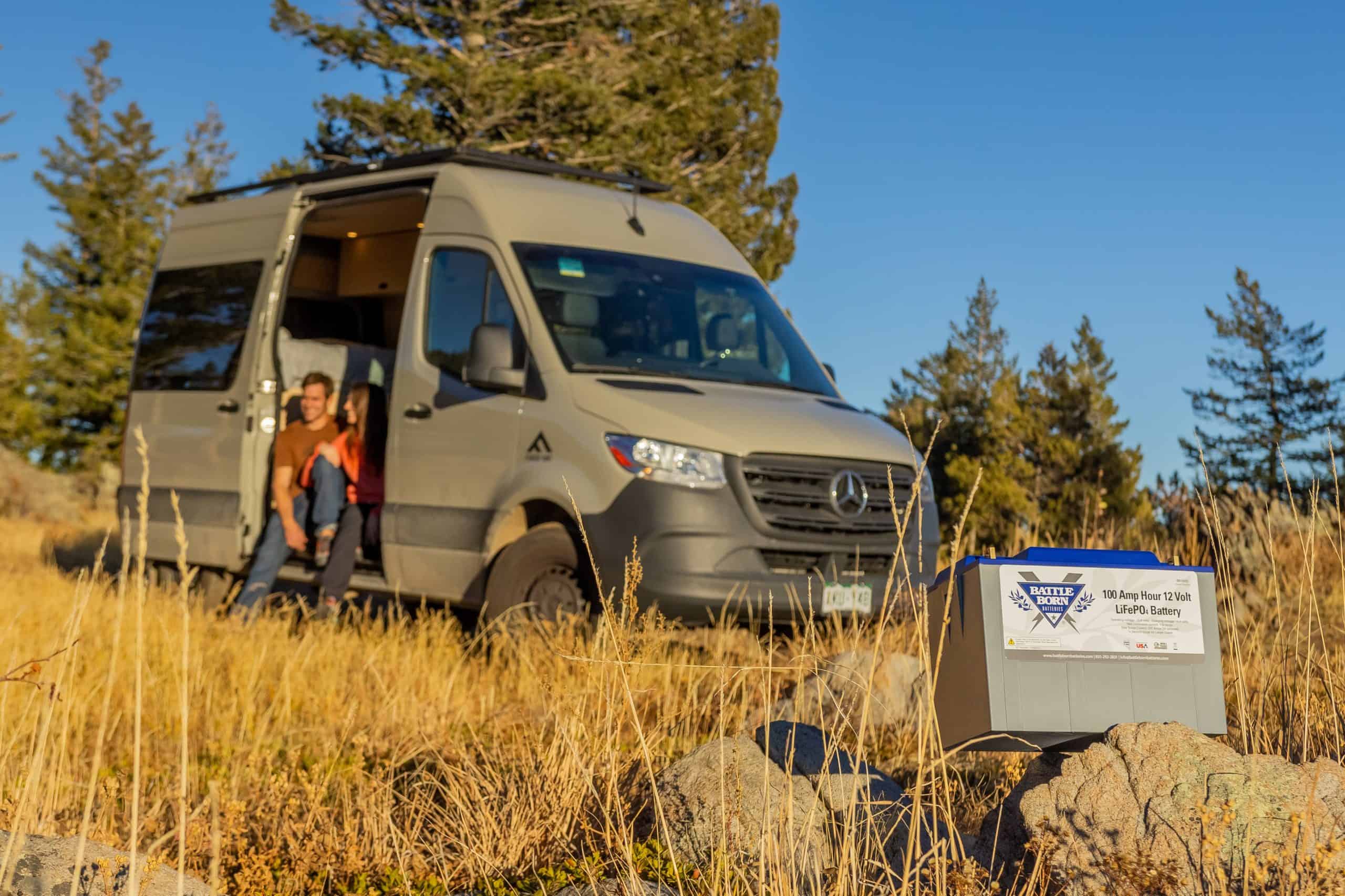
Our team of dedicated engineers and battery experts are always just a phone call away to answer your questions and make your switch to lithium seamless.
We’re here to help you understand how our batteries work and how to implement them in a system that’s right for you.
Can’t find what you’re looking for in our FAQs?
Give us a call at (855) 292-2831 or get in touch at [email protected].
How did we choose the Battle Born name?
Our company headquarters is in Reno, Nevada. We love our great state so much we decided to use the state slogan as our brand name.
Today Nevada is playing a pivotal role in revolutionizing energy storage, and Reno is at the epicenter of the li-ion battery world.
Battery giants Tesla and Panasonic are operating the world’s largest battery factory just a stone’s throw away from our headquarters. We at Battle Born Batteries are honored to be in such great company, and we want to continue helping Nevada lead the charge in revolutionizing li-ion batteries.
Are your batteries safe?
Our batteries are safe. All Battle Born Batteries use the safest and most stable components, including a LiFePO4 cathode and a built-in Battery Management System (BMS).
The BMS protects the cells against excessively high or low voltages, high currents, short circuits, and excessive heat or cold. These are the most common causes of battery failures, and we have taken every precaution to mitigate these risks in all of our batteries.
In addition, all of our cells are manufactured in a state-of-the-art automated facility, and each cell is cycled multiple times to ensure quality and consistency.
Li-ion batteries can be safer than lead acid batteries, which have no protection against ground faults. Our built-in BMS that protects against ground faults.
We strive to include all the best safety features into our battery, and this is what makes us a leader in the deep cycle replacement market. We are constantly developing new innovations to increase safety in our batteries.
Why are LiFePO4 batteries more expensive than alternatives?
The upfront cost of our lithium deep cycle battery is higher than a lead acid equivalent. But, when you divide that cost by the life of the battery, our LiFePO4 battery is already cheaper than a lead acid battery.
When cost and time associated with changing the batteries is factored in, you really save a bundle when you decide to install a Battle Born battery bank. Able to run 3,000 cycles, most people will have these batteries for 10 to 15 years.
How do I choose the correct lithium deep cycle battery for my application?
In most standard 12, 24, or 48 volt systems the best choice of lithium battery is LiFePO4 (Lithium Iron Phosphate). The voltage of this type of battery is very similar to an AGM and will work great with readily available system components for your RV, boat, or off-grid power system.
If you have a device that requires a higher voltage of DC power, please email us at [email protected] or call (855) 292-2831 and we will help you find the right battery for your application.
How do I size a li-ion battery bank for my system?
Sizing a battery bank for an off-grid or mobile power system can get complicated if you don’t have all the information you need to make the right calculations. You will need some basic information to get started.
You will need the maximum and continuous draw – in amps or watts – of the devices you want to power. These are usually found somewhere on the device on a sticker or plate that shows the amps and volts of that device or the power in watts.
As an example, let’s just say that our system needs to run 10 amps at 120 volts for 3.5 hours.
10 amps x 120 volts = 1200 watts of power.
1200 watts x 3.5 hours = 4200 watt-hours of energy.
Next you need to convert 4200 watts-hours to direct current (DC) amp-hours. For our example, we will use a 12 volt battery bank.
4200 watts-hours / 12 volts = 350 DC amp-hours of battery energy needed for our sample application.
Also, the battery needs to be able to deliver 1200 watts/ 12 volts = 100 amps of power.
We will use the 100 amp-hour Battle Born battery to build this system.
350 amp-hours / 100 amp-hours = 3.5
We would need to use four 100 amp-hour LiFePO4 Battle Born Batteries to power this system.
How do I know what size cable to use in my system?
When considering cable sizing there are a few factors to consider.
First, what is the size of the load you are powering with the battery bank?
Second, how far away from the battery is the load? You can do voltage drop calculations to see if you need to step up your cable size.
Here is an easy reference chart:
As a rule of thumb, you can use these numbers as a guideline.
-4 AWG wire approximate max rating is 157 amps DC
-1/0 AWT wire approximate max rating is 291 amps DC
-4/0 AWT wire approximate max rating is 456 amps DC
What is the difference between series and parallel connection?
There are two different ways of connecting batteries together to make a larger bank.
- Parallel Connections – These connections are used when you want to increase the amperage of your battery bank. Most commonly, parallel-only connections are found in 12 V systems. The connections on this type of battery bank go from positive to positive and negative to negative, when you connect this way, you double your amps (see the diagram below).
- Series Connections – This type of connection is used when you need to increase the voltage of your battery bank. You will find these types of battery connections in all types of battery banks including 12 V, 24 V, 48 V systems. The connections in this type of battery bank are different than parallel. Your batteries will be connected from positive to negative, linking the batteries together to increase the voltage of your battery bank (see diagram below).
*If you plan to wire your batteries in series, please let us know when you place your order so we can make sure to match your capacity.
In some instances when you have a larger size battery bank, it is common to have both series and parallel connections in your battery bank (see diagram below).
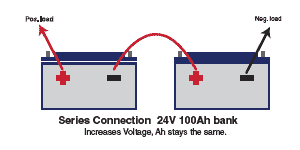
Is my device compatible with your batteries?
Please check the manual of your device and see if it is capable of being programmed for the following settings:
Charging Voltages/Parameters:
- Bulk/absorb: 14.2 – 14.6 V
- Float: 13.6 V or lower
- No equalization (or set it to 14.4 V)
- No temperature compensation
- Absorption time: is 30 minutes per battery (if it’s an option)
Where can I find wiring examples?
We have wiring schematics available under the various system pages on our website.
If you do not find one that meets the requirements/specifications for your system, please email us at [email protected] or call (855) 292-2831 and we will assist you.
Where can I purchase your batteries?
You may purchase Battle Born Batteries directly from our website on the Shop Page.
Additionally, you can order by phone Monday through Friday 8 AM to 4:30 PM at (855) 292-2831 or email us at [email protected].
Where can I find product manuals and data sheets?
When you receive your shipment of Battle Born Batteries, you will find an insert featuring a QR code where all Battle Born Battery model manuals, cutsheets, and data sheets are located.
You can also access all Product Manuals and additional information at BattleBornBatteries.com/Manuals.
What does "drop-in replacement" actually mean?
Our batteries are drop-in replacements for typical lead acid batteries. This means that our batteries are designed to fit like a normal Group 27, 31 and GC2 battery in your bank.
This, however, does not mean our batteries are plug and play. Our batteries still may require specific components and programming to run your application.
To figure out if your components will work with our batteries, give us a call at (855) 292-2831 or send us an email at [email protected].
How long do Battle Born Batteries last?
As an update to this video, our batteries come with a 10-year warranty (8-year full replacement manufacturer’s defect warranty and 2 years prorated).
They are designed to last 3000 – 5000 cycles, at which point the battery will still hold 75 to 80% of its energy capacity.
Can LiFePO4 batteries be mounted in any position?
Yes, you can mount your battery in any position. There is no acid inside of the battery, and the small amount of liquid electrolyte is contained within each sealed cell.
You can decide what is best for your application. Our lithium technology gives you the flexibility to put the battery in places you normally would not have placed a lead acid battery.
Are your batteries designed to handle vibration?
Our batteries are assembled and constructed with the highest quality components available. They are designed to withstand vibration and keep working for thousands of cycles.
You will need to check your connections from time to time (as with any kind of battery) to make sure they maintain good contact from cable to battery.
Can your battery get wet?
The batteries are sealed and can handle being in a moist environment. Like any other electronics, you should not submerge them in water.
How can I check my batteries voltage?
To learn how to check the voltage of your battery, watch the above video and have your multi-meter ready!
How do I winterize my batteries?
Please watch the video above for more information on winterizing your Battle Born Batteries.
The storage temperature range is -10°F to 140°F (-23°C to 60°C). We recommend bringing the Battle Born Batteries to a 100% charge and then disconnecting them completely for storage. After six months in storage your batteries will remain 75 – 80% charged.
Storing batteries in subzero weather (-15°F or more) has the potential to crack the ABS plastic and more importantly could cause a faster loss of capacity, in some cases drastically more than the typical 2 – 4% per month loss.
Are there any temperature restrictions on Battle Born Batteries?
Battle Born Batteries protect themselves from charging in cold temperatures and won’t accept a charge once the internal cell temperature drops to 24°F. At this point they will continue to discharge even down to -4°F. At this temperature we recommend no longer pulling power to avoid damaging the batteries.
Insulated battery boxes, heating blankets, and placing your battery bank inside your RV will help keep the temperature stable. On the high end of temperature range, the batteries will shut down once 135°F is reached.
What is the maximum amperage I can charge my batteries at?
Our batteries allow a charge rate of 50 amps for each 100 Ah battery. For more than one battery, you can simply take the entire Ah of the bank and cut the number in half.
For example, three 100 Ah Battle Born batteries total 300 Ah. Cut this number in half and you have your maximum recommended charge rate of 150 amps.
Do your batteries have an internal heating element for cold temperature use?
Yes, we offer heated versions of many of our battery models. Visit battlebornbatteries.com/heated-battery-kits for available options.
Can I use your batteries in cold cranking applications?
Our battery is designed as a deep cycle storage battery and doesn’t offer the cold cranking amps most applications require for starting.
Multiple batteries connected in parallel can be used in an emergency situation, but prolonged use in starting applications can result in a diminished capacity or damage to the battery’s management system.
The continuous discharge rate of our batteries is 100 amps, 200 amps for 30 seconds and higher loads for ½ second. Cold cranking applications typically exceed 200 amps which will cause our batteries to shut off.
When storing batteries upwards of a few months, what do I need to do to protect them?
The best way to store our batteries for an extended period is to fully charge them and then disconnect them from everything. Removing the negative lead from the battery bank is also recommended.
The batteries do not need a trickle charge or maintenance while stored. They will only lose around 2 – 3% of their charge per month. If possible, we recommend storing them in a temperature above freezing.
Storing batteries in subzero weather (-15°F or lower) has the potential to crack the ABS plastic and could lead to a greater loss in charge. In some cases they can lose much more than the expected 3% monthly loss.
If you are storing your entire system, we recommend the use of a battery guard, which will help protect your batteries by disconnecting them from parasitic loads once they reach a voltage of 11.5 V.
How many more amps do I get in my system if I add another battery?
For each additional 12 V 100 Ah battery you add to your system, you get another 100 amps of continuous discharge and 200 amp for surge for 30 seconds.
For each additional 50 Ah battery you add to your system, you get another 60 amps of continuous discharge and a 100 amp surge for 30 seconds.
How much do your batteries weigh?
Battle Born Batteries are 1/5th of the weight of a traditional lead acid battery when matching the same usable capacity. This can result in a significant reduction in gross vehicle weight, not to mention being easier to load, install or move if necessary.
The BB10012 and BBGC2 are both 12 V 100 Ah and weigh 31 lbs.
The BB5012 is our 12 V 50 Ah battery and weighs 17 lbs.
BB5024 is our 24 V 50 Ah battery and weighs 31 lbs.
Do I need to install all of my batteries at the same time, or can I add additional batteries later?
Lead acid battery manufacturers will state: “do not mix old and new batteries. Doing so will reduce overall performance and may cause battery leakage or rupture.” They also recommend replacing all batteries within a bank at the same time.
A partially used lead acid battery will drain energy from a new one, reducing the total amount of battery power available.
This is not the case with Battle Born LiFePO4 batteries. You can add new batteries to your original Battle Born bank up to two years down the road without damaging, reducing lifespan, or harming them in any way.
Can your batteries start my Onan generator?
Onan are one of the most popular generators on the market for RV applications. Most RVs and campers come equipped with a generator, and the Onan is compact enough to fit into most camper’s cargo spaces.
Onan Generators startup requirements typically run between 360 and 475 cold cranking amps. Although two of our batteries will almost always start your on-board generator, three of our batteries are an ideal match.
Are your batteries water resistant or waterproof?
Battle Born Batteries are water-resistant and splash-proof, but remember that water and electricity are a bad combination. Prolonged exposure to a high-moisture environment may cause water to penetrate the battery and cause irreversible damage. Like with most electronics, never submerge a Battle Born battery.
We offer a waterproof seal that can be added to any of our batteries. In many marine or high humidity environments, these seals greatly can reduce the overall risk.
How do I size a battery bank for my system?
Not sure how many amp hours you need for your power system? Battle Born explains how to size your battery bank for your specific system.
How should I store my lithium batteries during the winter?
Not sure how to store your Battle Born lithium-ion batteries during the cold and winter months? Battle Born Batteries has the necessary recommendations for you, including keeping a 50% charge or higher on the batteries, disconnecting them, and then storing somewhere above -10 degrees Fahrenheit.
How do I prep my Battle Born lithium batteries to be wired in series?
For a higher voltage system, Battle Born recommends individually charging Battle Born lithium-ion batteries fully to 14.4V before wiring in series.
Do I have to buy a special charger for LiFePO4 batteries?
As mentioned above in the video, the battery prefers to bulk charge at 14.4 volts and float at 13.6 volts. Most standard chargers can handle these settings.
Some chargers are made for lithium, and will, in most cases, charge faster than a standard charger.
How long will it take to charge?
The length of time it takes to charge a li-ion deep cycle battery depends on the type and size of your charging source.
Our recommended charge rate is 50 amps per 100 Ah battery in your system. For example, if your charger is 20 amps and you need to charge an empty battery, it will take 5 hours to reach 100%.
We don’t recommend you exceed this charge rate as it can lead to a shortened battery cycle life. In an emergency situation the battery can be charged at a quicker rate if needed.
What is the rate of discharge and how does it affect the capacity of the battery?
The rate of discharge is how fast you are pulling power from a battery. It’s important to take this into account as most lead acid batteries have a 20-hour rate. That means the advertised capacity in amp hours is based on the fact that you will pull the power out slowly over 20 hours. If you discharge the battery in 5 hours, you will get less energy out of the battery than you would at 20 hours.
Our LiFePO4 (Lithium Iron Phosphate) batteries will deliver their advertised power, even if you discharge them in an hour. A sealed lead acid battery discharged in an hour will give you about 40 amp-hours.
What is depth of discharge (DoD) and how does it affect a battery?
When a battery is discharged, the amount of energy taken out will determine the depth at which it was discharged.
How Do I Figure it Out?
If you have a 100 amp–hour battery and use 50 amp-hours, you have discharged the battery 50% (which means the depth of discharge is 50%).
If you took the same battery and discharged it only 20 amp–hours, or 20% of the battery, your depth of discharge will be 20%. This is an important number to keep in mind. Depending on which type of battery you are using, the number of cycles will vary based on your depth of discharge.
Most lead acid batteries experience a significantly reduced cycle life if they are discharged more than 50%. That can result in less than 300 total cycles.
Conversely, LiFePO4 (Lithium Iron Phosphate) batteries can be continually discharged to 100% and there is no long-term effect. You can expect to easily get 3000 – 5000 cycles at this depth of discharge.
What are the charging parameters? What chargers do you recommend?
This video will walk you through the required battery charging parameters and a couple chargers that we recommend.
Our charging parameters consist of the following:
- Bulk/absorb = 14.2 – 14.6 V
- Float = 13.6 V or lower
- No equalization (or set it to 14.4 V)
- No temperature compensation
- Absorption time is 20 minutes per battery (if it’s an option)
12 V
Bulk/absorb 14.2 – 14.6 Volts (we usually recommend 14.4) float 13.6 Volts or lower
No equalization (or set it to 14.4 V), no temperature compensation and absorption time is 20-30 minutes per battery (if it’s an option).
24 V
Bulk/absorb 28.4 – 29.2 V (we usually recommend 28.8 V) float 27.2 V or lower
No equalization (or set it to 28.8 V), no temperature compensation and absorption time is 20 minutes per battery (if it’s an option).
To view the chargers in our Battle Born Shop, please click here.
If you need assistance with charging parameters or settings for a certain device, give us a call at (855) 292-2831 or email us at [email protected].
What is a battery cycle?
A cycle is the process of fully charging and discharging a battery.
Typically, lead acid batteries cannot be cycled below 50% depth of discharge. If you go lower than 50% you can significantly shorten the lifespan of the battery.
Our LiFePO4 batteries can be discharged nearly 100% for thousands of cycles without shortening their lifespan.
How can I charge a LiFePO4 battery?
You can use any standard charger, solar or wind charge controller to charge our LiFePO4 deep cycle battery.
There are some chargers and controllers that are programmable to ensure full usage out of your battery, but most will have an AGM setting which normally bulk charges about 14.4 volts and float at 13.6 volts. These levels are great for your Battle Born battery.
How many solar panels do I need?
Answering this question can depend on the amount of space you have on your vehicle and how fast you want your bank to charge.
As a general guideline we recommend 200 to 250 watts of solar per 100 amp-hours of battery. This will give you the ability to charge from nearly empty to full in a six to eight-hour time frame.
Many factors can change this calculation and you are invited to call at (855) 292-2831 or email us at [email protected] if you would like to discuss in greater detail.
How do I wire the Victron MultiPlus-II?
Victron’s MultiPlus-II Inverter Charger is designed for a 50 amp service with two hot legs of power. With all the functionality of a MultiPlus and a MultiGrid, the Multiplus-II is a great option for those with 50A 120/240VAC split-phase applications.
Whether it is supplied from shore power or a generator, the MultiPlus-II can accept and pass through both lines of a 120/240V supply, with the capability to utilize the full 50A for charging and AC loads.
How do I program the Orion DC/DC Charger?
Orion’s DC/DC Chargers are for use in dual battery systems in vehicles or on boats where the (smart) alternator and the start battery are used to charge the service battery. The unit can be monitored and programmed via Bluetooth and can be remotely controlled via a remote on/off switch and has an engine running detection mechanism.
What is a BMS?
BMS stands for battery management system. This is the brain of our deep cycle lithium battery.
The BMS protects the lithium cells from getting damaged in several scenarios.
1. From low or high voltage, low or high temperatures, if there is a short in the system, it will shut off. The BMS shuts off the battery to protect the li-ion cells and the user from unsafe operating conditions.
2. The BMS also regulates the amount of power you can take out of the battery. On our 100 amp-hour battery, the BMS is rated to 100 amps continuous, 200 amps for 30 seconds, and any higher loads for ½ second.
3. Our BMS also keeps all the cells in balance. At the top of each charge cycle, the BMS reduces the charging rate in cells that have been topped off first, letting the rest of the cells catch up. This ensures that the cells are always in balance and maintains the quality and efficiency of the pack.
What are the BMS output ratings?
Our Battery Monitoring System, or BMS is rated to 3 different levels.
- 100 amps continuous (1200 watts at 12 volts) – this means you can pull 100 amps out of the battery when you need it until the capacity is all used up.
- 200 amps for 30 seconds (2400 watts at 12 volts) – if your device has a surge an individual battery can deliver 2400 watts for 30 seconds.
- ½ second surge up to the max capacity of the battery. If you have a high momentary over 200 amps the battery will handle this for ½ second.
*Keep in mind that when you have two batteries in parallel you will double these surge numbers. With four batteries in parallel you will quadruple these figures.
Does the BMS control charging?
The internal battery management system (BMS) inside Battle Born Batteries will not limit the charging current.
We recommend a 50 amp charge rate for a 100 Ah battery. You can charge at a higher charge rate of 100 amps in emergency situations where it is necessary, but we don’t recommend it for long periods of time.
How do I install and enable the heated component?
What do I do for long term storage of the battery?
When it comes to storage, we designed our batteries to be hassle free. All you need to do is disconnect the enable wire, make sure your battery is at least 50% charged, and safely store it.
What do I do if my Battery Dies?
If your battery is in low voltage disconnect, simply apply a 12V charge and it will start accepting a charge. However, if you’re in a cold environment with low voltage disconnect and the cold temperature shutdown won’t accept a charge, still connect it because the internal heated function and the heater circuit still operate to get the battery up to a safe internal charging temperature and remove the cold temp shutdown of the BMS, allowing it to charge fully.
What is the Resting Draw of the Battery?
The resting draw of the heater enable in the BB10012H is 0A. It will only draw power when the heat enable is engaged and the internal temperature of the battery reaches 35F.
How much power does the heated battery consume?
On average, the heated battery consumes an average of 1.8 amps. Our tests indicate that at 0 degrees Fahrenheit, with no insulation, the heater is on about 30% of the time. With no external charging or loads it gives approximately 185 hours of heat capability before the battery goes into low voltage disconnect. With warmer temperatures you can consume less power and if you insulate your batteries you can extend the usage as well.
*Please note all values are based off of a testing environment meant to simulate a battery box in cold conditions, duty cycle values and overall draw may vary based off of environmental conditions*
Is all the power consumed within the battery?
All power for the internal heat device is within the battery. If you have an external monitoring system or BMV, that power will not be recorded if or when the heater turns on. The devices will need to be recalibrated if that occurs.
How does the heated technology work?
Allowing you to get out into cold temperatures and stay out there longer has never been easier thanks to this heat technology! The heater will be activated when the internal temperature reaches approximately 35 degrees Fahrenheit. Make sure to always disconnect the heater when storing the battery.
Does the 10-year warranty apply to this product?
Every Battle Born Battery, including our heated line, is backed by an industry-leading 10-year warranty. Headquartered in Reno, NV, it’s easier and quicker in the event of a warranty issue. Please note that the warranty is non-transferrable.
Voltage Meters 101 - How to Use & How to Troubleshoot
From checking the AC output to amperage to continuity, here’s everything you need to know about troubleshooting your lithium power system with a voltage meter.
How to Program Your BMV Battery Monitor
Learn about how a BMV works in your electrical system and how to program it using through the Victron Connect app.
Explore more about BMVs here.
Breakdown of the VE.Bus Smart Dongle
The VE.Bus Smart Dongle by Victron works to monitor your Victron Multiplus Inverter/Charger and will also act as a temperature and voltage sensing device. Everything can be monitored by the VE.Bus Smart Dongle through the Victron Connect app.
What Is a Lynx Distributor and Why Do I Need One?
The Victron Lynx Distributor is a modular DC bus bar, with locations for four DC fuses. The device will monitor the status of each fuse and indicate its condition with a LED on the front.
